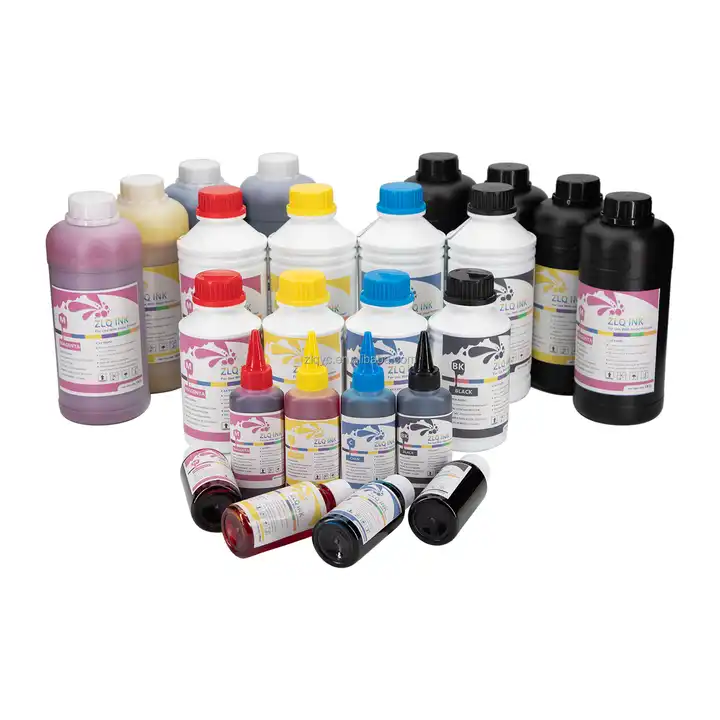A customer inquired about the differences in the application of DTF ink and DTG pigment ink. I will analyze this issue in detail. Before analyzing, let's first talk about the names of DTG pigment inks currently available in the market. Some are called DTF textile printing ink, while others are called film transfer ink. In fact, the names DTF textile printing ink and film transfer ink are quite broad. DTF textile printing ink will be more direct, mainly emphasizing the application of DTF pigment ink.
To get back to the point, DTF textile printing and direct to cotton printing are both applications of pigment ink. So, what is the difference between their applications?

1. Different processes
The biggest difference between the two applications is the process. The application of DTF textile printing ink is to print the ink on a heat transfer film, then sprinkle a layer of hot melt powder on the surface of the heat transfer film, and then produce color through compression; And DTG ink is directly printed on the fabric. In order to achieve better color and color fastness, fabrics often need to be used together with pre-treatment and post-treatment liquids during the printing process. The process of DTF printing is relatively complex and often requires more professional clients to streamline the entire DTG printing solution. The DTF printing process is relatively simple, making it easy for customers to quickly master the process, and easy to replicate and promote. This is also an important reason why DTF printing programs are so popular.
2. Different hand feel
Based on the differences in application processes between the two mentioned above, in terms of hand feel, direct spraying of DTG pigment ink will definitely perform better. This is because in DTF printing applications, there is a layer of hot melt powder between the ink and the fabric. Use hot melt powder as a binder to transfer ink onto the fabric. The natural feel is slightly worse than the feel of direct coating. DTG pigment ink is directly printed on fabrics, so there is generally no tactile issue. In terms of hand feel, direct spraying applications have significant advantages. On the other hand, with the maturity of DTF printing technology and the improvement of the performance of hot melt powder applications, the finished products produced by DTF printing applications can also meet the needs of market customers.
3. Different color expression and fastness
DTF printing applications are more outstanding in terms of color expression. Similarly, DTF printing performs better in terms of fastness. In order to improve color and fastness, direct spraying applications often require a combination of pre-treatment and post-treatment liquids to achieve better results, and the use of hot melt powder in DTF printing applications perfectly solves the problems of color difference and fastness. Using hot melt powder as a binder, the pigment ink is perfectly combined with the fabric, resulting in excellent color performance and fastness after color development. Color difference and fastness issues are very troublesome problems in DTG printing applications. Using hot melt powder as an intermediate medium, the pigment ink adheres well to the fabric, perfectly solving the old problems of color and fastness in DTG printing applications.
4. Different costs of solutions
At present, the application machines for DTF printing still mainly use Epson 4720 nozzles, while DTG printing mainly uses industrial nozzles. The cost difference between the machines used by the two is significant. In terms of ink prices, the DTF textile printing ink used in the 4720 machine is also cheaper than the DTG printing ink. The biggest cost of DTF printing applications is thermal transfer film, and the price of thermal transfer film continues to decline. Overall, the cost of DTF printing is lower than that of DTG printing. The DTF printing program has a low investment threshold, simple process, and is easy to get started and replicate, so it has developed rapidly and become popular in a short period of time.
The above is what my friends and I shared about the differences between DTF textile printing ink and DTG pigment ink. At present, both of these solutions belong to the digital application of pigments. Both have their own advantages and disadvantages. The market positioning and customer base are still very large. Differences. DTF printing will undoubtedly become the mainstream solution for personalized applications, while cotton digital printing will be the main application of DTG directly applied to clothing printing. The two solutions complement each other and will become the backbone of the rapid development of digital printing for coatings.

